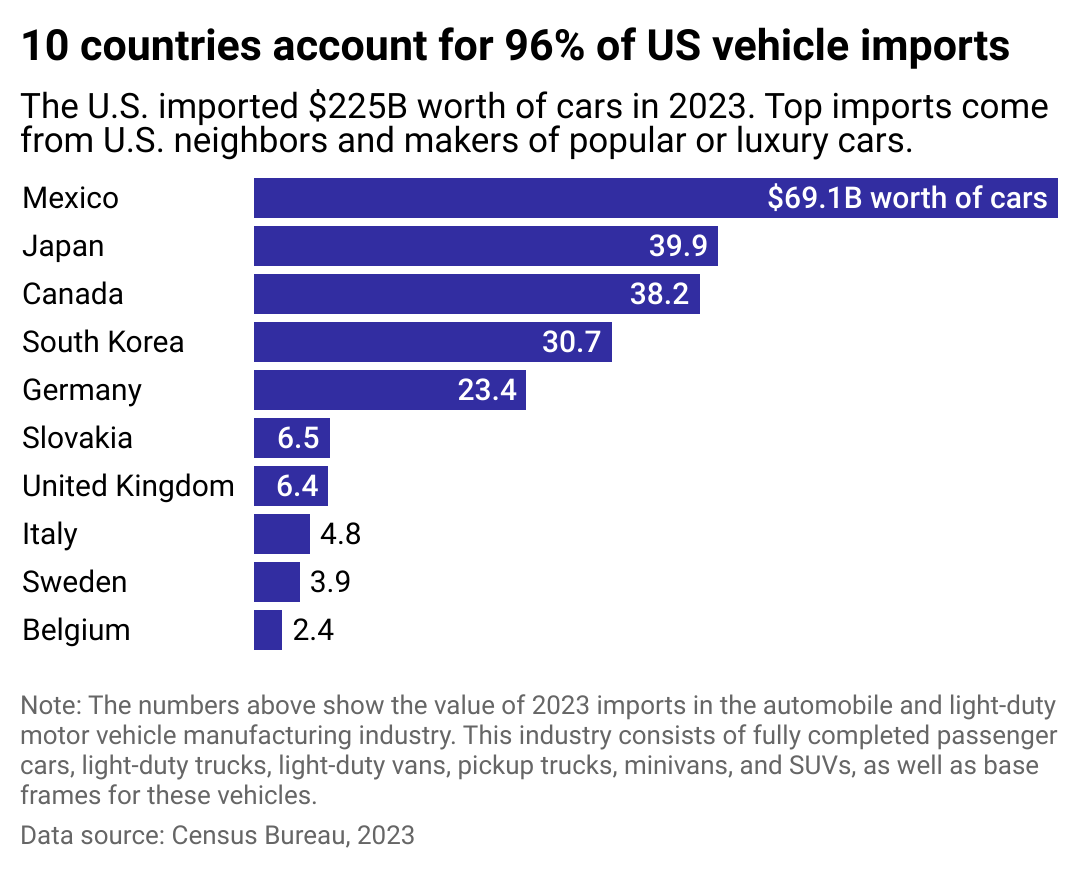
These 10 countries send the most cars to the US
This story originally appeared on CoPilot and was produced and distributed in partnership with Stacker Studio.
These 10 countries send the most cars to the US
As one of the most car-dependent societies on the globe, it's no surprise that Americans have a massive appetite for imported vehicles. The United States is the largest car importer in the world, bringing in more than $234 billion in passenger vehicles in 2023, according to Census Bureau data.
Close to half of car imports (by value) came from the country's North American neighbors, Mexico and Canada. But Americans also imported vehicles in large quantities from Asia and Europe. CoPilot used Census Bureau trade data to determine which countries export the most cars to the U.S. Rankings are based on the total value of passenger vehicle imports.
Overall vehicle sales fell in the last few decades as more people opted to maintain, repair, pass down, or resell the often long-lasting machines. In step with this decline, the sales gap between domestic and foreign cars has narrowed dramatically.
Historically, domestic cars were favored conspicuously over imported cars. In 1967—the first year that the Bureau of Economic Analysis reported the data—domestic car sales were nearly tenfold that of foreign cars. In 2023, that ratio was about 2.6 domestic cars for every foreign car sold, which has remained relatively consistent over the past two decades. Importantly, the BEA data considers vehicles assembled in Mexico and Canada to be domestic, so it's challenging to gauge how sales of U.S.-specific vehicles stack up.
American-made vehicles still top the charts: Of the 10 top-selling new vehicle models of 2023, six were from U.S. manufacturers. The other four were made in Japan, which is the second-largest U.S. vehicle importer by value. Read on for a more detailed look at countries sending the most cars to the U.S.

North America, Asia lead in car exports to the US
Two predominant car importers are the nation's closest neighbors: Mexico and Canada. Though neither has a homegrown car brand with much acclaim in the U.S., each one is home to manufacturing and assembly plants for some of the largest American and foreign car companies, including Dodge, Ford, Chevrolet, Chrysler, Toyota, Honda, GMC, and more.
To some degree, the abundant vehicle trade between the U.S., Mexico, and Canada is due to parts being shipped across borders several times in the manufacturing process before fully assembled vehicles make it to their final destination. With collaborative trade agreements in place, vehicles made in Mexico and Canada can be imported to the U.S. without added import taxes. In 2023, restrictions eased on what vehicles qualified for duty-free imports, facilitating even more car trade between the North American nations. Each country increased its vehicle exports to the U.S. by more than $10 billion from 2022-2023.
Two Asian countries, Japan and South Korea, round out the top four vehicle exporters to the U.S. Japan is home to Toyota and Honda, which make some of the most favored cars in the U.S., including the Toyota Rav4, Toyota Camry, Toyota Tacoma, and Honda CRV. Nissan is another Japanese car company, which has grown its U.S. footprint in recent decades and sells hundreds of thousands of cars to U.S. consumers annually. Hyundai and Kia, based in South Korea, are also popular car brands among Americans. Growing demand for electric and hybrid cars, in particular, pushed imports of South Korean vehicles to new heights last year.
Six European nations round out the top 10 vehicle importers. Several of these send fewer, higher-value luxury cars to the U.S., such as Audi, Mercedes, and BMW cars from Germany; Ferrari, Lamborghini, and Maserati cars from Italy; and Bentley, Mini, and Jaguar cars from the U.K. Others house manufacturing facilities for other major car brands, such as Slovakia, which builds Kia and Volkswagen vehicles.
Many American car companies also have manufacturing plants abroad. Ford, the quintessential American car company, has manufacturing and assembly facilities across the globe. Rising auto leader Tesla has plants in China, Germany, the Netherlands, and Canada.
The U.S. imports far more cars than it sends out but remains a leading vehicle manufacturer in the global market. It is second only to China in production volume. In 2023, U.S. car exports were worth about $66 billion—substantial, but less than one-third the value of car imports. In many cases, the U.S. sends the most cars to countries from which it receives them: Canada, Germany, Mexico, South Korea, Belgium, and Japan. The final four top recipients of U.S. passenger vehicles are China, Saudi Arabia, the United Arab Emirates, and Australia.
Story editing by Nicole Caldwell. Copy editing by Tim Bruns.



